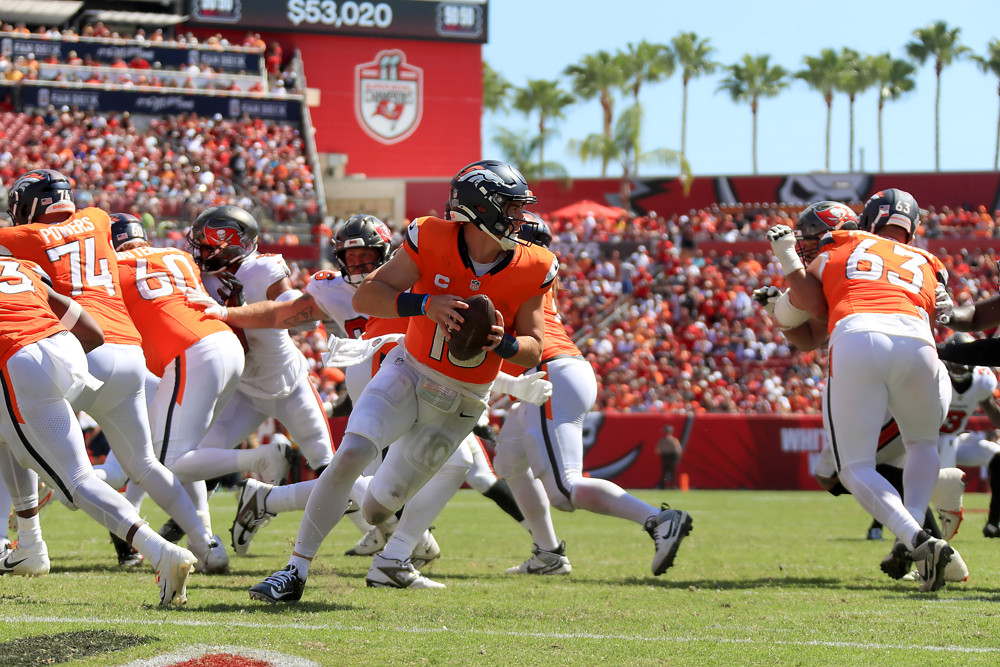
Last year, the downtrodden and winless Denver Broncos took a Week 3 trip to the Sunshine State for what was, on paper, a matchup nightmare against an undefeated squad, and they got embarrassed to a historic degree, 70-20.
This year, the Broncos found themselves in an eerily familiar position, but this time, the defense and passing attack managed to lead the team to victory.
Who starred in the Week 3 romp, and who watched their role with the team get thrown into jeopardy? Let’s look.
DENVER BRONCOS STOCK UP

Denver Broncos Passing Attack
Week 3 was almost as pretty for the Denver Broncos passing attack as Weeks 1 and 2 were ugly.
After Weeks 1 and 2, the Broncos ranked 31st in Expected Points Added per dropback (EPA/dropback) and 30th in dropback success rate. The only passing attack they were decisively better than was Bryce Young’s bench-worthy start to the season.
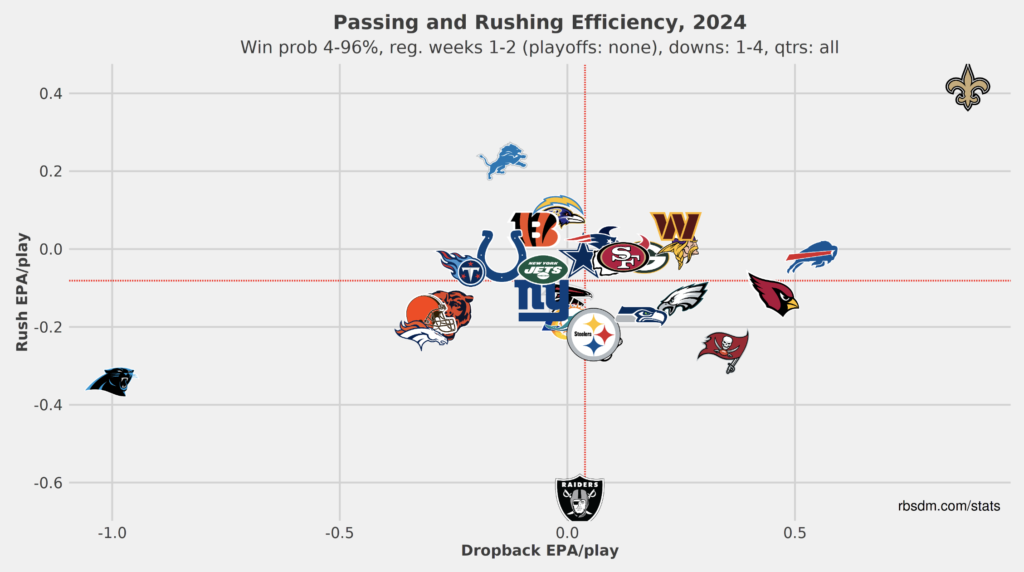
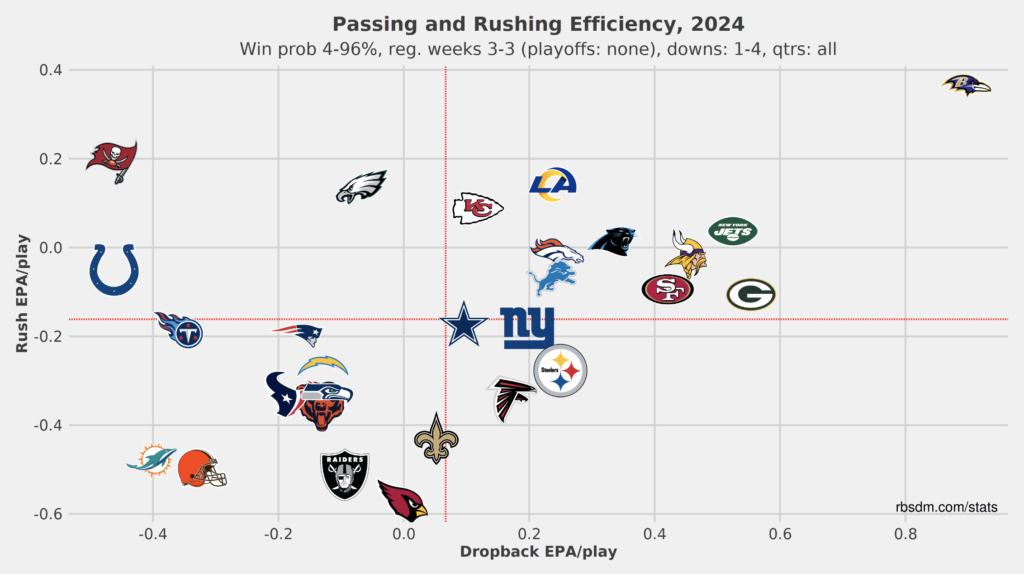
In Week 3, Denver lept all the way up to 11th in EPA/dropback and fourth in dropback success rate. The only passing attacks ranking ahead in both categories were the New York Jets and Detroit Lions.
The scoreboard and the raw, old-fashioned stats reflect similar leaps from the passing game. So, what changed?
The goal of this season is to see progress from Bo Nix.
— Jacob Romano (@JTR_14) September 23, 2024
In previous weeks, Nix almost certainly would have felt the pressure from the blitz and drifted backwards.
Instead, he keeps his feet set, stands tall, and delivers an accurate strike to Sutton. pic.twitter.com/SPiYZbDwcz
First and foremost, Bo Nix played a lot better.
Nix with the shoulder roll deep – right to the checkdown for room to run…
— Ben Fennell (@BenFennell_NFL) September 23, 2024
The Drew Brees Special. pic.twitter.com/hHvCeJ3N5l
Let’s call a spade a spade, Nix’s lack of NFL experience and general struggles were major problems for Denver’s aerial attack. Were there other problems for the passing game that weren’t Nix’s fault? Absolutely, but it’s also ok to acknowledge that a rookie is probably going to limit that attack when faced with two top-three defenses, like those in Seattle and Pittsburgh, that currently rank first and third in EPA/dropback allowed.
Nix went from being a liability on anything that wasn’t a short pass (5-for-22 for 132 yards, four interceptions, two big time throws, and four turnover-worthy plays, through the first two weeks on throws past 10 yards) to being completely acceptable when firing downfield in Week 3 (4-for-8 for 80 yards, 0 interceptions, two big time throws, and one turnover-worthy).
Nix ➡️ Sutton, Back Shoulder Dime pic.twitter.com/Hs1rGuU36y
— Tim Jenkins (@TJenkinsElite) September 23, 2024
Most critically, on deep throws, Nix was exceptional, making two pinpoint throws downfield early that immediately left Bowles and Co. stumbling.
Thing of beauty. Nix to Reynolds.#Broncos take the early lead on the road in Tampa.
— Taylor Kilgore (@TaylorKilgore33) September 22, 2024
pic.twitter.com/gdDoq5XZA1
Interestingly enough, the rookie’s average air yards per attempt sat at 6.8, which wasn’t that different from the 6.2 air yards per attempt he achieved in the Seattle game. The reason that game felt so compact and Week 3 felt so open was the difference in Nix’s proficiency.
Nix’s accuracy improvement is closely tied to another major area of growth — the footwork. In his first two regular season games, Nix’s feet were, frankly, terrible. He was seldom setting them before unloading a pass, even when he had a clean pocket or plenty of room to step up, leading to some wild sprays.
The pocket presence in general was better from Nix. On Sunday, the Broncos didn’t suffer a single quarterback-created pressure, after owning the league’s ninth-worst rate of creating such pressures through Weeks 1 and 2.
The improved pocket feel and game sense were on full display on Nix’s wild highlight-reel-worthy scramble.
🚨🚨INSANE PLAY🚨🚨#BRONCOS ROOKIE QB BO NIX MADE ONE OF THE MOST ATHLETIC PLAYS BY A QB YOU WILL SEE.
— MLFootball (@_MLFootball) September 23, 2024
FOR SOME REASON NO ONE IS TALKING ABOUT THIS…
(🎥 NFL)
pic.twitter.com/sL7NNIrss8
Bo Nix 👀’s in the back of his head fam pic.twitter.com/WCTNaqXmF4
— Tim Jenkins (@TJenkinsElite) September 23, 2024
The receiver play and utilization was also much improved.
Troy Franklin and Marvin Mims Jr. having their highest snap counts of the season opened up more space for Nix to work with, and he took advantage.
Marvin Mims (@marvindmims) with a great effort on this NOW screen to Troy Franklin.
— Patrick Chiotti (@PatrickChiotti) September 24, 2024
LB came off the edge and had the size advantage, Mims does a great job holding his own and resetting his hands. Watch til the end to see his reaction 😤 pic.twitter.com/ExU6Fmi8ty
Nix also didn’t have a single one of his passes dropped in Week 3, after struggling with the seventh-worst drop rate the previous weeks.
The pass protection took a big step forward too. Nix went from seeing a pressure on 43% of dropbacks to seeing one on just 25% of dropbacks. That step is made more impressive by the fact Tampa sent a blitz on 44% of Nix’s dropbacks, compared to the 31% he saw in Weeks 1 and 2.
Alex Palczewski was a bright spot too, working as a fill-in for Mike McGlinchey. He leaves a lot to be desired in the run game, but finding a UDFA tackle who can be as stable in pass-protection as Palczewski was in his first career start is a major boon. On Nix’s 40 dropbacks the first-time starter allowed two pressures, the same number as Garett Bolles.
I don’t think Alex Palczewski is auditioning to take Mike McGlinchey’s starting spot this season
— Nick Kendell 🏔 (@NickKendellMHH) September 23, 2024
But he certainly is auditioning for a starting spot on the OL for 2025 given Bolles’ impending free agency
The team also just looked more well-coached, in general. The execution errors weren’t nearly as problematic, as demonstrated by the aforementioned accuracy, receiving, and blocking gains. The opening script was also tremendous.
Sean Payton deserved blame for the execution shortcomings, and deserves credit for the turnaround. Now, it better not regress.
Brandon Jones
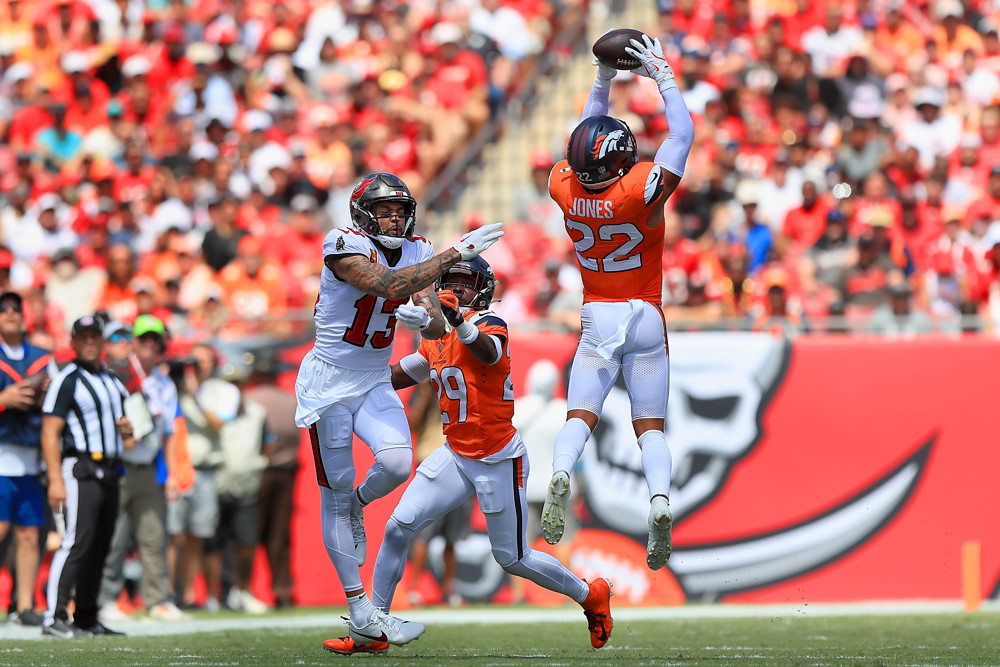
Brandon Jones didn’t have the best debut for the Denver Broncos, as he was allowing a passer rating of 89.5 when targeted and had already missed three tackles entering Week 3.
Against the Buccaneers, Jones might have been the very best and/or the most impactful player on the field.
Baker Mayfield is picked, and the Broncos are in striking range of a two-score lead
— The Irish NFL Show (@IreNFL) September 22, 2024
pic.twitter.com/WjZfpRCv6Z
In the first half, Jones punished Mayfield for targeting Mike Evans, watching the quarterback’s eyes the entire play and swooping in for an interception, which he returned inside the Bucs’ 10-yard line. That led to the Broncos’ second touchdown of the day, and put Tampa in a 14-0 hole.
Jones started the blood-letting and, in the game’s final moments, he delivered the killing blow too. With the Bucs driving late and clammoring for hope of a comeback, abig Riley Moss hit knocked the ball loose, and Jones swooped in to scoop up the fumble. Plus, once again, Jones offered a nice return, setting Denver up near midfield.
Denver Broncos Pass Rush
I suspect someone involved with our photo service is on the Tampa Bay Buccaneers payroll, because, considering how constant the Broncos’ harassment of Baker Mayfield was, it is beyond suspicious that requests for photographic evidence of the assault through this service offer as much return as requests for ‘Bigfoot’ or ‘UFO’ imagery.
Thankfully, these shadowy figures are not the arbiters of truth.
The Denver Broncos sacked the quarterback seven times for the first time since COVID landed stateside. Only Deshaun Watson was sacked more this weekend, and Watson has to deal with all the universe’s karmic and spiritual forces bearing down on him, along with Brian Burns and Dexter Lawrence
The seven sacks for the Broncos today were their most in a game since 2019. Two came from Dondrea Tillman in his first NFL start.
— Nick Kosmider (@NickKosmider) September 22, 2024
"After that first one, everybody's trying to hunt to get that (sack)," Tillman said.
The defense wore playing with a lead quite well.
Mayfield was pressured on 40% of his dropbacks, tied for the weekend’s 10th-highest rate, according to PFF, for a total of 16 pressures, tied for fifth-most.
The Broncos pass rush was dominant vs. TB:
— Jordan Lopez (@JordanTLopez) September 23, 2024
Denver had the fastest team average pass rush get-off in Week 3 (excluding MNF games) at 0.71
Zach Allen led the team in QBP and was tied for 2nd in the league in Week 3 at 7 total pressures
Bonitto and Cooper both had 4 as well pic.twitter.com/m658tylFGJ
It’s the third game in a row where the Broncos’ pass rush has been a leading force, but the first since the Baron Browning injury, making this performance especially promising.
In Browning’s place, Dondrea Tillman stepped up and notched two sacks and three pressures on just 13 pass-rush snaps, and 19.2 Pass Rush Productivity (PRP) score was the best mark in the NFL this week among edge defenders with at least 10 pass-rush attempts.
🗣️🗣️🗣️ DE-FENSE
— Denver Broncos (@Broncos) September 22, 2024
📺: FOX pic.twitter.com/lokPlQqx8r
Along with Tillman, Zach Allen had a tremendous performance and terrorized the TB offense like an unhinged berserker. His five pressures bring his season-long tally up to 18, which currently leads all interior defensive linemen, and is tied for second, among all positions, with Micah Parsons. Bonitto also had arguably his best game of the season, adding four pressures and a pass rush win rate of 9.5%, which led the team’s edge rushers.
SACK.
— OFFSIDER NFL (@Offsider_NFL) September 22, 2024
🏈 Baker Mayfield se va al suelo y CONTINÚA el PARTIDAZO de los Broncos en Tampa.pic.twitter.com/0HwdCIQ6Ey
Tyler Badie
The controversy surrounding around the pronunciation of Tyler’s Badie name currently envelops Broncos Country, but fear not, LTB is here with an exclusive report to set the record straight once and for all.
It’s pronounced, ‘RB1’.
Or, at least, it should be, so long as the rushing attack with Javonte Williams and Jaleel McLaughlin remains woefully inefficient in comparison.
Tyler Badie’s top speed of 20.99 MPH on this run makes him the 3rd fastest ball carrier of Week 3, and 10th fastest ball carrier of the entire season on any one play.
— EpicNormie (@EpicNormie_) September 23, 2024
RB1.
pic.twitter.com/CDtKVoEqKN
The two lead backs have combined to tote the ball 42 times, tallying 92 yards, six first-downs converted, and one touchdown scored. With less than one-quarter of that same workload, at just 10 carries on the season, Badie has already rushed for 86 yards and has converted four first-downs.
Now, one would be right to mention that Badie’s rushing totals are buoyed by his 43-yard scamper on Sunday, but even without that outlying carry, his 4.8 yards per carry (YPC) more than doubles the 2.2 YPC that Williams and McLaughlin have offered this season. With that 43-yard rush included, his 8.6 yards per touch nearly quadruples what the Broncos’ primary backs have provided on the ground.
Plus, explosive runs are a necessity, and those plays haven’t come from the established backfield players. Through the first three weeks, Williams and McLaughlin have just one ‘explosive run’, which is defined as a carry of at least 10 yards, between them (McLaughlin’s 15-yard burst from Week 1), good for a rate of about 2.4%. Meanwhile, Badie already has carries of 43 and 16 yards on his limited touches, giving him an explosive run rate of 20%.
Tyler Badie shows vision, burst and power. Badie only carried the ball once and received 1 catch the entire game againstthe Steelers!! Where is the disconnect? Where is Mims, Badie, Franklin? Put the best players on the field and help Bo Nix!! @LockedOnBroncos pic.twitter.com/13tWSTNILm
— OnesNNzeroS (@OnesnnzeroS) September 19, 2024
This could all crater once the sample size increases, but the Denver Broncos must increase that sample so they can at least find out.
Pat Surtain II
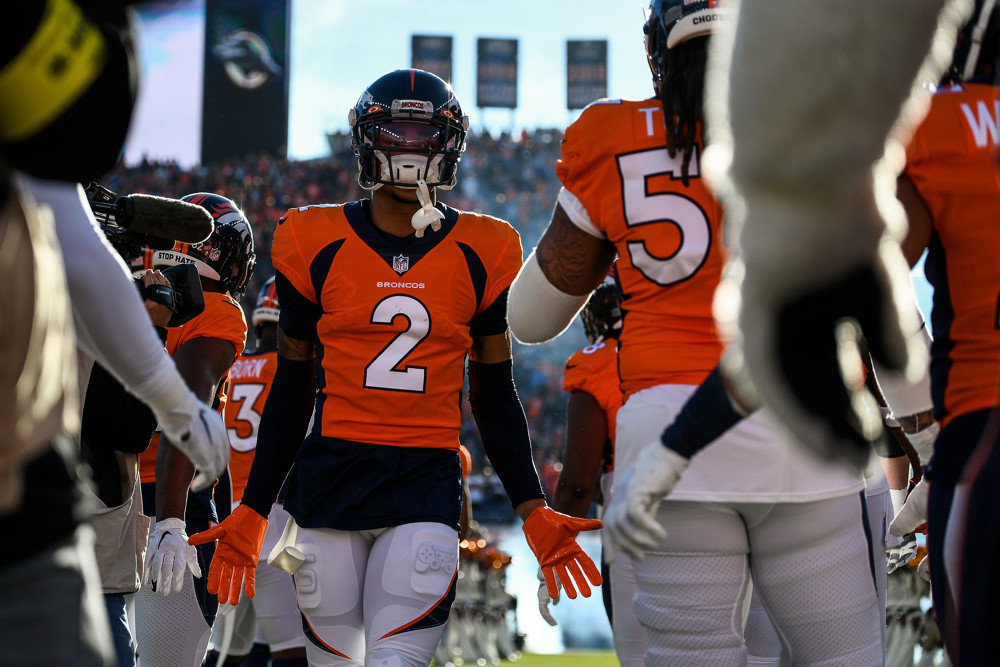
Pat Surtain II narrowly dodged scrutiny in last week’s ‘Stock Down’ section, because, upon a closer review of the film, it became clear he wasn’t as bad throughout the game as the most glaring moments might have indicated, even though the penalties were worthy of critique.
Nonetheless, PS2’s showing vs. the Steelers was far from lauded, unlike the game he just turned in against Mike Evans.
#Broncos got a QB Pressure from 13 different defensive players yesterday!! Damn. That unit was swarming vs TB!
— Ben Fennell (@BenFennell_NFL) September 23, 2024
And Patrick Surtain… Stud. Complete Stud. Run support. 1on1 vs Evans on 4th Down in RZ. Awesome stuff pic.twitter.com/wrYFyfBnMo
Surtain covered Evans on 24 of 34 routes, and on those 24 routes, Evans gained eight total yards, and Baker only dared to look his way one time. That one attempt was the only time Surtain was targeted all game. He operated as a true shutdown corner, and that elite play was instrumental to the pass rush, and, therefore, the defense’s.
Per Next Gen Stats: Surtain was on Mike Evan on 24 of his 34 routes. Evans finished with 2 catches for 17 yards.
— James Palmer (@JamesPalmerTV) September 23, 2024
Surtain and Sean Payton watched film of #saints CB Marshon Lattimore (who Payton believed had done well on Evans in the past) in preparation during the week. https://t.co/XpqMbD2dsE
BRONCOS STOCK DOWN

Greg Dulcich and Josh Reynolds
Almost everything went right for the Denver Broncos this weekend, so, considering we’ve already lambasted the running backs, we’re forced to reach a bit on these criticisms.
Greg Dulcich and Josh Reynolds didn’t struggle much this week (though Dulcich certainly did last week), but they did see their playing time dramatically decrease.
Reynolds was on the field for just 51% of the Broncos’ offensive snaps in Week 3, compared to 80% in Week 1. Once Vele returns, that number is likely to only dwindle further.
Meanwhile, Dulcich has seen his snap share decrease from 67% in Week 1, to 54% in Week 2, and 25% in Week 3, after his ghastly showing against Pittsburgh.
So, where are the snaps going? Primarily Adam Trautman, Lil’Jordan Humphrey, Marvin Mims, and Troy Franklin, it seems.
Nix was a little too late on this throw. Part of me also thinks Franklin should've angled this route a bit more upfield to make the throw easier.
— Robby (@Robby_NFL) September 23, 2024
Plays like these are why I called for more Mims snaps, even if he doesn't get a target. Him downfield opens up so much space in the… pic.twitter.com/xlt5yNj9b8
Trautman started the season with a 35% snap share and now rests at 68%. Mims is up to 24%, after bottoming out at 15% in Week 2. Finally, Franklin has climbed all the way to a 25% snap share after starting Week 1 as a healthy scratch.
